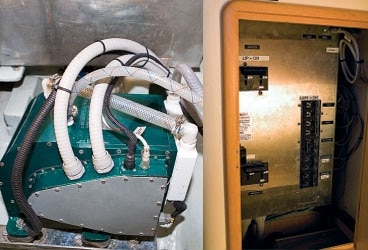
McGearyDiesel1
At Strictly Sail Miami last February, the Moorings 4300 Electric, built by Robertson and Caine, made its boat-show debut. (It had already been operating in the B.V.I. charter fleet for several months.) The model came into existence not because the builder had planned to introduce such an iteration but because its owner, Anthony West, decided he wanted a Moorings 4300. What’s more, he wanted a Moorings 4300 with a diesel/electric drive.
West, a Silicon Valley software engineer well versed in matters electrical and electronic, doesn’t believe that the boat’s expected charter use-short sails of two or three hours between islands and overnight anchoring-warranted the complexity of a regeneration system and its large banks of batteries. He wanted a pure diesel/electric system, along the lines of those that have been employed in submarines, locomotives, and ships for decades, so he elected to install the Ossa Powerlite direct-current system manufactured by Glacier Bay.
The boat’s 240-volt-DC electric motors are directly powered by the 25-kilowatt, 240-volt-DC generator. A control module regulates the current delivered to the motors (nominally rated at 26 kilowatts each but “detuned” to avoid overloading the generator) and distributes the generator’s 240-volt-DC output to such 240-volt-DC accessories as the water heater (and soon air conditioning) and to a battery charger that charges the 12-volt-DC house batteries. AC appliances and outlets are served by an inverter running off the 12-volt supply. The generator’s starting battery gets its charge from an alternator mounted on its diesel engine.
A principal reason for employing a DC generator is that it can respond to fluctuations in power demands by changing the speed at which it runs, in this instance between 2,300 and 3,500 rpm. As the controller senses more demand-when, for example, the “throttles” are advanced-it signals the generator to speed up. This gives the DC generator the potential to burn fuel more efficiently than an AC generator, which has to run at a fixed rate.
On the Moorings 4300 Electric, changes in generator speed were all but imperceptible; the generator’s sound shield and its location forward of the saloon in a locker accessed from the bridgedeck made it barely audible from the cockpit.
Because the Ossa Powerlite system is pure diesel/electric and doesn’t employ regeneration, folding or feathering propellers can be fitted to help the boat’s performance under sail.
Jeremy McGeary is a CW contributing editor.








